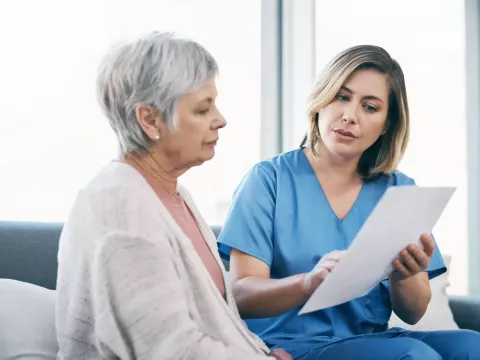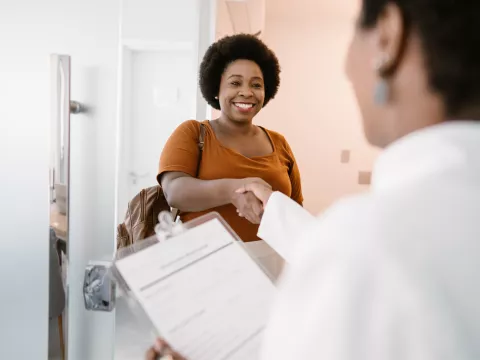- AdventHealth

If you're wondering about bone density screenings, you're not alone. Many women and men ask themselves the same questions every year. Is it age- or gender-related? Does it mean I have osteoporosis? What exactly is my bone density? How do I read the results?
We're here with our expert, Christopher Wasyliw, MD, a musculoskeletal radiologist at AdventHealth, to help answer all these questions and more with everything you need to know about osteoporosis and bone density screenings.
Bone Basics
Your bones are made of living, growing tissue with three components that make them strong:
- Collagen, a protein that gives bones a flexible framework
- Calcium-phosphate mineral complexes that make bones hard and strong
- Living bone cells that remove and replace weakened sections of bone
Typically, you make more bone than you lose until sometime between the ages of 18 and 25, when you reach peak bone mass. According to the National Osteoporosis Foundation, the more bone you have at the time of peak bone mass (density), the less likely you are to break a bone or get osteoporosis later in life.
As we age, however, we tend to lose more bone mass than we form. And it speeds up once we hit middle age. Menopause has a big impact on bone loss in women, as bone density has been shown to decrease when estrogen levels drop.
What Happens With Bone Loss?
Dr. Wasyliw explains, “Osteoporosis occurs when you lose too much bone, make too little or both. Your bones weaken and become porous, putting you at a higher risk of fractures.”
He continues, “Osteoporosis is considered a silent disease; you can't feel your bones weakening and many only learn about their bone loss if an accident happens or they break a bone. Women have smaller bones and tend to lose bone mass due to hormonal changes around the time of menopause, making them more likely to have osteoporotic fractures.”
How Many People Have Osteoporosis?
About 54 million people are affected by osteoporosis and bone loss. Some studies suggest that 1 in 2 women and 1 in 4 men, age 50 and older, will break a bone because of osteoporosis. Risk factors to consider for osteoporosis include:
- Being over age 50
- Being female and going through menopause
- Breaking a bone
- Having rheumatoid arthritis
- Having a parent who broke a hip
- Having low vitamin D levels
- Taking certain medications, such as steroids or proton pump inhibitors
- Tobacco or alcohol use (more than two drinks a day for women)
What Is a Bone Density Scan?
A bone density scan, also called a dual-energy X-ray absorptiometry (DEXA or DXA), measures the strength of your bones and their chance of breaking. It's a low-dose X-ray that takes about 10 minutes and can diagnose osteoporosis. Most often, it's performed on the lower spine and hips.
DEXA With TBS
Your trabecular bone score (TBS) is determined using your DEXA scan and allows your doctor to assess your risk of future fractures more accurately, with no additional radiation or time needed. A TBS can lead to a more accurate diagnosis, early prevention and treatment.
DEXA with TBS has been shown to significantly improve the capability of identifying patients at high risk for an osteoporotic fracture and aid in patient management.
"Evaluating bone mineral density alone can be misleading as it’s affected by degenerative endplate sclerosis, facet arthrosis and other factors that affect bone microarchitecture, but not always bone density," says Dr. Wasyliw. "TBS has proven to be an additional aid in characterizing a patient's fracture risk profile."
Your doctor can provide you with a referral for a DEXA scan with TBS.
Do I Need a Bone Scan if I'm Under Age 65?
Most people younger than 65 only need a DEXA scan if they're at increased risk of a fracture, as determined by the World Health Organization's (WHO) 10-year Fracture Risk Assessment Tool (FRAX).
A DEXA is recommended if your risk is equal to or greater than that of a 65-year-old woman (9.3% as determined by FRAX). Your doctor can help you calculate your fracture risk (FRAX).
Who Should Get a Bone Density Scan?
“Women should get a bone scan beginning at age 65. Men 70 and older may want to talk with their doctors before deciding. Younger women and men should consider the test if they have risk factors for serious bone loss, as indicated by the FRAX risk assessment,” shares Dr. Wasyliw.
How to Prevent and Treat Osteoporosis
There are ways to prevent and treat weak bones to stave off osteoporosis. The universal recommendations for bone health are the same throughout our lives despite our bone density, including consuming a healthy diet with adequate calcium, doing daily exercise and assuring we have sufficient vitamin D levels. If your DEXA scan results indicate you're at high risk of fracture, you and your doctor can consider medications.
How to Read Your Test
Your radiologist will review your DEXA scan. The radiology report includes clear language stating whether your bone mineral density is normal, osteopenic or osteoporotic, as well as follow-up recommendations.
DEXA scans and mammograms are often performed at the same facilities and can usually be done during the same visit. Always talk to your primary care physician if you have questions and be sure to get your DEXA if recommended.
Leading-Edge Medical Imaging Technology
At AdventHealth, our team of skilled radiologists works with the area’s most-advanced medical imaging technologies for faster diagnosis and treatment.
Learn more about our medical imaging services or reversing osteoporosis with these tips. You deserve to feel whole.




